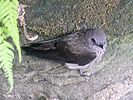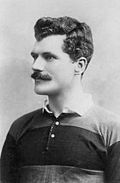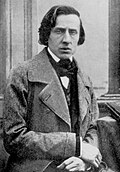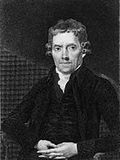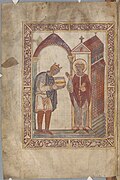| << | Today's featured articles for October 2014 | >> | ||||
|---|---|---|---|---|---|---|
| Su | Mo | Tu | We | Th | Fr | Sa |
| 1 | 2 | 3 | 4 | |||
| 5 | 6 | 7 | 8 | 9 | 10 | 11 |
| 12 | 13 | 14 | 15 | 16 | 17 | 18 |
| 19 | 20 | 21 | 22 | 23 | 24 | 25 |
| 26 | 27 | 28 | 29 | 30 | 31 | |
October 1
Mucho Macho Man (foaled 2008) is a retired American Thoroughbred racehorse who won the 2013 Breeders' Cup Classic. Named after the Village People song "Macho Man", he was owned for most of his racing career by Dean and Patti Reeves of Reeves Thoroughbred Racing, and trained by Kathy Ritvo. Born late in the year for a Thoroughbred foal, as a growing two- and three-year-old he had to compete against horses that were several months older. In 2011, he competed in all three Triple Crown races, finishing third in the Kentucky Derby. After surgery in 2011 to address a breathing problem, he came back and won three graded stakes races and finished a close second in the 2012 Breeders' Cup Classic. Winning that race in 2013 (pictured with jockey Gary Stevens), combined with the compelling human-interest stories surrounding the horse and the people who worked with him, earned him the Secretariat Vox Populi Award and the National Thoroughbred Racing Association Moment of the Year. Mucho Macho Man won another race in January 2014 and was retired in July due to "wear and tear", but essentially sound. He now lives at Adena Springs where he will stand at stud. (Full article...)
Recently featured: Pengkhianatan G30S/PKI – 1940 Brocklesby mid-air collision – Derek Jeter
October 2
Madeline Montalban (1910–1982) was an English astrologer and ceremonial magician who co-founded the esoteric organisation known as the Order of the Morning Star (OMS), through which she propagated her own form of Luciferianism. After moving to London in the early 1930s and immersing herself in its esoteric subculture, she taught herself ceremonial magic and associated with significant occultists, including Aleister Crowley and Kenneth Grant, and Wiccans like Gerald Gardner and Alex Sanders. From 1933 until her death she wrote magazine articles on astrology and other esoteric topics. In 1952 she met Nicholas Heron, with whom she entered into a relationship, and they founded the OMS as a correspondence course in 1956, teaching subscribers their own magical rites. Viewing Lucifer as a benevolent angelic deity, she believed Luciferianism had its origins in ancient Babylon, and encouraged her followers to contact angelic beings associated with the planetary bodies to aid their spiritual development. Having refused to publish her ideas in books, Montalban became largely forgotten following her death, although the OMS continued under new leadership. (Full article...)
Recently featured: Mucho Macho Man – Pengkhianatan G30S/PKI – 1940 Brocklesby mid-air collision
October 3
Meerkat Manor is a British television programme produced by Oxford Scientific Films for Animal Planet International that ran for four series between September 2005 and August 2008. Blending more traditional animal documentary style footage with dramatic narration, the series told the story of the Whiskers, one of more than a dozen families of meerkats in the Kalahari Desert being studied as part of the Kalahari Meerkat Project, a long-term field study into the ecological causes and evolutionary consequences of the cooperative nature of meerkats. With the success of the programme in the UK, Animal Planet started broadcasting it on its national channels in Australia, Canada, and the US. It has since been rebroadcast in more than 160 other countries. Although the show faced criticism from viewers for not intervening when a meerkat was injured and faced death, as a whole Meerkat Manor enjoyed considerable success, and its experimental format broke new ground in animal documentary filming techniques. It was nominated for two Primetime Emmy Awards in 2007, and was a winner at the 2006 Omni Awards and at the 2006 and 2007 New York Festivals Award Galas. (Full article...)
Part of the Meerkat Manor featured topic.
Recently featured: Madeline Montalban – Mucho Macho Man – Pengkhianatan G30S/PKI
October 4
A metalloid is a chemical element that has properties in between those of metals and nonmetals. There is no standard definition of a metalloid, nor is there agreement as to which elements are appropriately classified as such. Despite this uncertainty, the term remains in use in chemistry literature. The six commonly recognised metalloids are boron, silicon, germanium, arsenic (pictured), antimony and tellurium. Elements less commonly recognised as metalloids include carbon, aluminium, selenium, polonium and astatine. Typical metalloids have a metallic appearance but are brittle and only fair conductors of electricity. Chemically, they mostly behave as weak nonmetals. They can form alloys with metals. Most of their other properties are intermediate in nature. Metalloids and their compounds are used in alloys, biological agents, flame retardants, glasses, optical storage and optoelectronics, pyrotechnics, semiconductors and electronics. The term metalloid originally referred to nonmetals. Its more recent meaning, as a category of elements with intermediate properties, became widespread in 1940–1960. Metalloids are sometimes called semimetals, a practice that has been discouraged. (Full article...)
Recently featured: Meerkat Manor – Madeline Montalban – Mucho Macho Man
October 5
Mom & Me & Mom is the seventh book in author Maya Angelou's series of autobiographies. The book was published in 2013, shortly before Mother's Day and Angelou's 85th birthday. It focuses on her relationship with her mother, Vivian Baxter. The book explains Baxter's behavior, especially her abandonment of Angelou and Angelou's older brother when they were young children. It also chronicles Angelou's reunion and reconciliation with Baxter. Mom & Me & Mom is an overview of Angelou's life and revisits many of the anecdotes related in her previous books. Angelou was one of the first African American female writers to openly discuss her life through autobiography, upholding the long traditions of African American autobiography but challenging the usual structure of the autobiography by critiquing, changing, and expanding the genre. Like Angelou's previous autobiographies, Mom & Me & Mom received mostly positive reviews. Most reviewers state that Baxter is presented well in the book. Pictures of Angelou, Baxter, and members of their family appear through the book. An audio version, read by Angelou, was released in CD form and as a digital download. (Full article...)
Part of the Maya Angelou autobiographies featured topic.
Recently featured: Metalloid – Meerkat Manor – Madeline Montalban
October 6
The Mascarene martin is a passerine bird in the swallow family that breeds in Madagascar and the Mascarene Islands. The nominate subspecies occurs on Mauritius and Réunion and has never been found away from the Mascarene Islands, but a smaller Madagascan subspecies is migratory and has been recorded wintering in East Africa or wandering to other Indian Ocean islands. The Mascarene martin is small with grey-brown underparts becoming white on the throat and lower abdomen, dark grey-brown upperparts and a slightly forked tail. The underparts are heavily streaked with black. It nests in small colonies anywhere with suitably sheltered sites for constructing a nest. It has a heavy flight with slow wingbeats interspersed with glides, and frequently perches on wires. It feeds on insects in flight, often hunting low over the ground or vegetation. A number of internal and external parasites have been detected in this species. Tropical cyclones can adversely affect populations on the smaller islands, but the Mascarene martin is a locally common bird with an apparently stable population and is classed as a species of Least Concern by the International Union for Conservation of Nature. (Full article...)
Part of the Phedina featured topic.
Recently featured: Mom & Me & Mom – Metalloid – Meerkat Manor
October 7
Marquee Moon is the 1977 debut album by American rock band Television. By 1974, the band had become a prominent act on the New York music scene and generated interest from a number of record labels. They rehearsed extensively in preparation for the album and, upon signing to Elektra Records, recorded most of the songs in single takes. Television's frontman Tom Verlaine and fellow guitarist Richard Lloyd eschewed contemporary punk rock's power chords in favor of rock and jazz-inspired interplay, melodic lines, and counter-melodies. Verlaine's lyrics for the album combined urban and pastoral imagery, references to lower Manhattan, themes of adolescence, and influences from French poetry. Marquee Moon was critically acclaimed upon its release and achieved unexpected commercial success in the UK, but sold poorly in the United States. It has since been viewed by critics as one of the greatest albums of the American punk rock movement and a cornerstone of alternative rock. The band's innovative post-punk instrumentation on the album strongly influenced the indie rock and new wave movements of the 1980s, as well as rock guitarists such as John Frusciante, Will Sergeant, and The Edge. (Full article...)
Recently featured: Mascarene martin – Mom & Me & Mom – Metalloid
October 8
John Hay (1838–1905) was an American statesman and official whose career in government stretched over almost half a century. After graduation from Brown University in 1858, Hay read law in his uncle's office in Springfield, Illinois, adjacent to that of Abraham Lincoln. Hay worked for Lincoln's successful presidential campaign, and became his assistant private secretary at the White House. Through the years of the American Civil War, Hay was close to Lincoln, and stood by his deathbed after the President was shot at Ford's Theatre. In 1897, President William McKinley, for whom he had been a major backer, made him Ambassador to the United Kingdom. The following year, Hay became United States Secretary of State. He served almost seven years, under McKinley, and after his assassination, under Theodore Roosevelt. Hay was responsible for the Open Door Policy in China, and negotiated the Hay–Pauncefote Treaty (1901) with the UK, as well as the Hay–Herrán Treaty (1903) with Colombia, and the Hay–Bunau-Varilla Treaty (1903) that cleared the way for the building of the Panama Canal. Hay was also an author and biographer, and wrote poetry and other literature through much of his life. (Full article...)
Recently featured: Marquee Moon – Mascarene martin – Mom & Me & Mom
October 9
The Ostend Manifesto was a document written in 1854 describing the rationale for the United States to purchase Cuba from Spain, and declaring that the U.S. would be "justified in wresting" the island from Spanish hands if Spain refused to sell. Cuba's annexation had long been a goal of Southern slaveholding expansionists, although U.S. national leaders had been satisfied to have it remain in Spanish hands rather than those of Britain or France. At the suggestion of Secretary of State William L. Marcy, three American ministers in Europe (Pierre Soulé (pictured), James Buchanan and John Y. Mason) met in Ostend, Belgium, to discuss strategy related to acquisition of Cuba. To Marcy's chagrin, the flamboyant Soulé had made no secret of the meetings, causing unwanted publicity in the U.S. and Europe. The administration of President Franklin Pierce was finally forced to publish the contents of the dispatch, which caused it irreparable damage. The manifesto was immediately denounced in the Northern states and Europe, and it became a rallying cry for Northerners seeking to control the vote on slavery. The question of Cuba's annexation was effectively set aside until the late 19th century. (Full article...)
Recently featured: John Hay – Marquee Moon – Mascarene martin
October 10
Arthur Gould (1864–1919) was a Welsh international rugby union centre and fullback who was most associated as a club player with Newport Rugby Football Club. He won 27 caps for Wales and critics consider him the first superstar of Welsh rugby. A talented all-round player and champion sprinter, Gould could side-step and kick with either foot. He never ceased practising in order to develop his fitness and skills, and was considered the outstanding player of his time. In 1893 Gould led Wales to their first Home Nations Championship and Triple Crown titles; the match against England that year established him as a great player and captain. During his international career he played twice at fullback, and 25 times at centre. He was Wales’ most capped centre until the record was surpassed by Steve Fenwick in 1980. He ended his international career with an 11–0 win over England on 9 January 1897 in front of 17,000 supporters at Rodney Parade. It was Gould’s 18th match as Welsh captain – a record that stood until 1994. Towards the end of his career Gould was at the centre of a controversy over a fund collected in his honour which saw Wales temporarily withdraw from international rugby. (Full article...)
Recently featured: Ostend Manifesto – John Hay – Marquee Moon
October 11
The Battle of Cape Esperance took place on 11–12 October 1942 between the Imperial Japanese Navy and U.S. Navy in the Pacific campaign of World War II. The second major surface engagement of the Guadalcanal Campaign, it took place at the entrance to the strait between Savo Island and Guadalcanal in the Solomon Islands. The Japanese sent a major supply and reinforcement convoy to their forces on Guadalcanal. At the same time, five warships (under the command of Rear Admiral Aritomo Gotō) were to bombard the Allied airfield on Guadalcanal. Shortly before midnight on 11 October, the Americans surprised Gotō's force, sinking two warships and heavily damaging another (Japanese cruiser Aoba, pictured). Gotō was mortally wounded and his other warships were forced to retreat. Meanwhile, the Japanese supply convoy unloaded and began its return journey without being discovered; four of its destroyers turned back to assist Gotō's retreating warships, but U.S. aircraft sank two of them. The battle did not give either navy operational control of the waters around Guadalcanal, but it provided a significant morale boost to the U.S. Navy after its heavy losses at the earlier Battle of Savo Island. (Full article...)
Part of the Guadalcanal Campaign featured topic.
Recently featured: Arthur Gould (rugby union) – Ostend Manifesto – John Hay
October 12
Drakengard is an action role-playing video game developed for the PlayStation 2 by Japan-based studio Cavia and published by Square Enix. The first game in the Drakengard series, it was released in Japan in September 2003 and in North America and Europe the following year; a version for mobile phones was also released in Europe. The player controls Caim, a deposed prince, and Angelus, a red dragon who forms a magical pact with Caim to save both their lives. The story follows their involvement in a religious war between the Union and the Empire, and their quest to protect magical seals that keep the world in balance. The game features a mixture of hack-and-slash ground-based missions controlling Caim, aerial combat with Angelus, and role-playing elements. It was conceived as a hybrid between the popular Dynasty Warriors series and the aerial combat game Ace Combat. Drakengard was the debut project for both producer Takamasa Shiba and writer and director Taro Yoko. It sold well in Japan and received mixed to positive reviews in the west: reviewers praised the game's story and music, but were mixed about the graphics and criticized the gameplay for being repetitive. (Full article...)
Recently featured: Battle of Cape Esperance – Arthur Gould (rugby union) – Ostend Manifesto
October 13
The Capitol Loop is a state trunkline highway running through Lansing, Michigan, in the United States that was commissioned on October 13, 1989. It forms a loop route off Interstate 496 through downtown near the Michigan State Capitol complex, home of the state legislature and several state departments. The trunkline follows a series of one-way and two-way streets through downtown Lansing, directing traffic to the State Capitol (pictured) and other government buildings. Unlike the other streets downtown, the seven streets comprising the Capitol Loop are under state maintenance and jurisdiction. The loop was originally proposed in 1986 as part of a downtown revitalization effort. Almost from the beginning the highway was affected by various controversies. Local community leaders suggested renaming the Capitol Loop for Martin Luther King, Jr., immediately before the state designated the highway. Reconstruction projects along the loop in 2004–05 were also contentious. In 2010, additional issues surfaced regarding the posting and enforcement of speed limits on city streets in Michigan, including the streets that make up the Capitol Loop. (Full article...)
Part of the Interstate 96 featured topic.
Recently featured: Drakengard – Battle of Cape Esperance – Arthur Gould (rugby union)
October 14
The Colorado River is the principal river of the Southwestern United States and northwest Mexico. Rising in the western Rocky Mountains, the 1,450-mile (2,330 km) river drains a vast arid region of the Colorado Plateau and the Mojave and Sonoran Deserts as it heads towards the Gulf of California. Known for its dramatic scenery (Horseshoe Bend pictured) and its whitewater, the Colorado carves numerous gorges, including the Grand Canyon in northern Arizona. For 8,000 years, the Colorado Basin was only sparsely populated by Native Americans, though some of their ancient civilizations employed advanced irrigation techniques. Even after becoming part of the U.S. in the 1800s, the Colorado River country remained extremely remote until John Wesley Powell's 1869 river-running expedition, which began to open up the river for future development. Since the completion of Hoover Dam in 1935, the Colorado has been tamed by an extensive system of dams and canals, providing for irrigation, cities, and hydropower. Today the Colorado supports 40 million people in seven U.S. and two Mexican states; with every drop of its water allocated, it no longer reaches the sea except in years of heavy runoff. (Full article...)
Recently featured: Capitol Loop – Drakengard – Battle of Cape Esperance
October 15
Tropical Storm Kiko was a strong tropical storm that capsized a boat off the western coast of Mexico, killing at least 15 people. The 15th and final tropical cyclone of the 2007 Pacific hurricane season, Kiko developed out of a tropical wave that formed off the coast of Africa on September 26 and traversed the Atlantic. The wave crossed over Central America and entered the Pacific Ocean on October 8, where it spawned Tropical Depression 15-E on October 15. The depression drifted to the south over the next day before briefly being declared Tropical Storm Kiko. It subsequently weakened into a tropical depression, but later reattained tropical storm intensity. By October 18, Kiko was forecast to make landfall along the western Mexican coastline as a moderate tropical storm. As a precaution, port captains in the area shut down shipping and residents were advised to avoid low-lying areas that might flood and to move to temporary shelters. The cyclone turned to the west without making landfall and reached its peak intensity of 70 mph (110 km/h) on October 20. The tropical storm slowly weakened to a remnant low-pressure area by October 24 and completely dissipated on October 27. (Full article...)
Recently featured: Colorado River – Capitol Loop – Drakengard
October 16
Tintin in Tibet is the twentieth volume of The Adventures of Tintin, the comics series by Belgian cartoonist Hergé. The cartoonist considered it his favourite Tintin adventure and an emotional effort, as he created it while suffering from traumatic nightmares and a personal conflict while deciding to leave his wife of three decades for a younger woman. The comic, serialised from 1958–59 in Tintin magazine, tells of the young reporter Tintin in search of his friend Chang Chong-Chen, whom the authorities claim has died in a plane crash in the Himalayas. Convinced that Chang has survived, Tintin leads his companions across the Himalayas to the plateau of Tibet, along the way encountering the mysterious Yeti. Themes in Hergé's story include extrasensory perception, the mysticism of Tibetan Buddhism (Tibetan monastery pictured), and friendship. Tintin in Tibet has been translated into 32 languages, is highly regarded by critics, and has been praised by the Dalai Lama, who awarded it the Light of Truth Award. The story was a commercial success and was published in book form in 1960; the series itself became a defining part of the Franco-Belgian comics tradition. (Full article...)
Recently featured: Tropical Storm Kiko (2007) – Colorado River – Capitol Loop
October 17
Frédéric Chopin (1810–1849) was a Polish composer and virtuoso pianist of the Romantic period. He grew up in Warsaw but left Poland, never to return, aged 20. He settled in Paris, obtaining French citizenship in 1835. From 1837 he maintained an often troubled relationship with the French writer George Sand. A brief and unhappy visit to Majorca with her was one of his most productive periods of composition. All of Chopin's compositions include the piano. Most are for solo piano, although he also wrote two piano concertos, a few chamber pieces, and some songs to Polish lyrics. Many contain elements of Polish folk music and of the classical tradition of J.S. Bach, Mozart and Schubert. His innovations in style, musical form, and harmony, and his association of music with nationalism, were influential throughout and after the late Romantic period. His music, his status as one of music's earliest "superstars", his association with political insurrection, his love life and his early death have made him a leading symbol of his era. His works remain popular, and he has been the subject of numerous films and biographies of varying degrees of historical accuracy. (Full article...)
Recently featured: Tintin in Tibet – Tropical Storm Kiko (2007) – Colorado River
October 18
The Battle of Caishi was a major naval engagement of the Jin–Song wars that took place on November 26–27, 1161. Although a peace treaty in 1142 had settled the border between the two states, putting the Jin in control of northern China and the Song in control of the south, Prince Hailing of Jin was intent on uniting them under a single emperor. Without much resistance, his army pushed through to the Yangtze River, which he planned to cross at Caishi, south of modern-day Nanjing. The Song were fortified along the Yangtze front. Hailing embarked from the shore of the Yangtze on November 26, but the Song fleet, equipped with trebuchets (example pictured) that launched incendiary bombs made of gunpowder and lime, decisively defeated the light ships of the Jin navy. Hailing was assassinated by his own men shortly after the battle. A military coup had taken place in his absence, enthroning Emperor Shizong, and a peace treaty signed in 1165 ended the conflict. Modern studies suggest that the battle was smaller and that both sides were more evenly matched than traditional accounts suggest. Nonetheless, the victory boosted the Song infantry's morale and halted the Jin's southern advance. (Full article...)
Recently featured: Frédéric Chopin – Tintin in Tibet – Tropical Storm Kiko (2007)
October 19
Briarcliff Manor is a suburban village in Westchester County, New York, less than 30 miles (48 km) north of New York City. Its motto is "A Village between Two Rivers", reflecting its location between the Hudson and Pocantico Rivers. It extends into the towns of Mount Pleasant and Ossining, and includes the communities of Scarborough and Chilmark. In the precolonial era, the area was inhabited by a band of the Wappinger tribes of Native Americans. In the early 19th century, the area was known as Whitson's Corners. Walter William Law moved to the area and purchased lands during the 1890s; he also developed the village, establishing schools, churches, parks and the Briarcliff Lodge. The village was incorporated in 1902, growing from 331 people when established to 7,867 in the 2010 census. It is primarily residential and has a relatively wealthy population. Its recreational facilities and parks, about 180 acres (73 ha), are all accessible to the public. The village has an elected local government, with departments including police, fire, recreation, and public works (Village Hall pictured). A 2012 study found it had the second-lowest crime rate in the state. (Full article...)
Recently featured: Battle of Caishi – Frédéric Chopin – Tintin in Tibet
October 20
James Chadwick (1891–1974) was an English physicist who was awarded the 1935 Nobel Prize in physics for his discovery of the neutron, and who led the British team that worked on the Manhattan Project during the Second World War to produce atomic bombs. He studied under Ernest Rutherford in Manchester and Hans Geiger in Berlin, where he demonstrated that beta radiation produced a continuous spectrum, not discrete lines as had been thought. He later became Rutherford's assistant director of research at the Cavendish Laboratory of the University of Cambridge. Chadwick's research led to his discovery of the neutron in 1932; he later measured its mass. In 1935 he became a professor at the University of Liverpool, which he made an important centre for the study of nuclear physics. During the Second World War, Chadwick carried out research as part of the Tube Alloys project to build an atomic bomb, and wrote the final draft of the MAUD Report, which inspired the U.S. government to begin serious atomic bomb research efforts. He later served as the British scientific advisor to the U.N. Atomic Energy Commission and as Master of Gonville and Caius College, Cambridge. (Full article...)
Recently featured: Briarcliff Manor, New York – Battle of Caishi – Frédéric Chopin
October 21
The Analytical Review was a periodical established in London in 1788 by the publisher Joseph Johnson (pictured) and the writer Thomas Christie. Part of the Republic of Letters, it provided summaries and analyses of new publications and acted as a forum for radical political and religious ideas. Although it aimed at impartiality, its articles were often critical of the British government and supportive of the French revolutionaries. While the journal had low circulation numbers for its day, it still influenced popular opinion and was feared by the administration of William Pitt the Younger. Government supporters founded the Anti-Jacobin Review in 1797, which criticized the radical politics of the Analytical and monitored it for unpatriotic and irreligious sentiments. The Analytical Review focused on politics, philosophy, natural history, and literature. Its prominent writers (who signed their work with pseudonymous initials) included the poet William Cowper, the moralist William Enfield, the physician John Aikin, and the polemicist Mary Wollstonecraft. It suspended publication in December 1798 after Johnson was convicted of seditious libel and other contributors had died or retired. (Full article...)
Recently featured: James Chadwick – Briarcliff Manor, New York – Battle of Caishi
October 22
Chorioactis is a genus of fungus that contains the single species Chorioactis geaster, an extremely rare mushroom found only in select locales in Texas and Japan. In the former, it is commonly known as the "devil's cigar" or the "Texas star"; in Japan it is called kirinomitake. It is notable for its unusual appearance. The fruit body, which grows on the stumps or dead roots of cedar elms (in Texas) or dead oaks (in Japan), somewhat resembles a dark brown or black cigar before it splits open radially into a starlike arrangement of four to seven leathery rays. The interior surface of the fruit body bears the spore-bearing tissue, and is colored white to brown, depending on its age. Fruit body opening can be accompanied by a distinct hissing sound and the release of a smoky cloud of spores. Fruit bodies were first collected in Austin, Texas, and the species was named Urnula geaster in 1893; it was later found in Kyushu in 1937, but the mushroom was not reported again in Japan until 1973. Although the new genus Chorioactis was proposed to accommodate the unique species a few years after its original discovery, it was not until 1968 that it was accepted as a valid genus. (Full article...)
Recently featured: Analytical Review – James Chadwick – Briarcliff Manor, New York
October 23
The Conte di Cavour-class battleships were a group of three dreadnoughts built for the Royal Italian Navy. The ships were completed during World War I, but did not see action. Leonardo da Vinci was sunk by a magazine explosion in 1916 and later sold for scrap. Conte di Cavour (pictured) and Giulio Cesare supported operations during the Corfu Incident in 1923 and were extensively reconstructed between 1933 and 1937 to add more powerful guns, armor and speed. Both ships participated in the Battle of Calabria in July 1940, when Giulio Cesare was lightly damaged. They were both present when British torpedo bombers attacked the fleet at Taranto in November 1940, and Conte di Cavour was torpedoed; repairs were not completed before the Italian surrender in September 1943, and she was scrapped in 1946. Giulio Cesare escorted convoys and participated in the Battle of Cape Spartivento in late 1940 and the First Battle of Sirte in late 1941. She was designated as a training ship in early 1942, and escaped to Malta after Italy surrendered. The ship was transferred to the Soviet Union in 1949 and used for training until she was sunk by a mine in 1955 and scrapped. (Full article...)
Recently featured: Chorioactis – Analytical Review – James Chadwick
October 24
The woolly mammoth was one of the last in a line of mammoth species. Its appearance and behaviour are among the best studied of any prehistoric animal due to the discovery of frozen carcasses (example pictured) in Siberia and Alaska, as well as skeletons, teeth, stomach contents, dung, and depiction from life in prehistoric cave paintings. The animal was only identified as an extinct species of elephant by Georges Cuvier in 1796. Its closest extant relative is the Asian elephant. The woolly mammoth was well adapted to the cold environment during the last ice age, and had long, curved tusks. Its habitat was the mammoth steppe, which stretched across northern Eurasia and North America. The woolly mammoth coexisted with early humans, who used its bones and tusks for making art, tools, and dwellings, and the species was also hunted for food. It disappeared from its mainland range at the end of the Pleistocene 10,000 years ago, most likely through a combination of climate change, consequent disappearance of its habitat, and hunting by humans. Recreation through cloning has been proposed, but this is as yet infeasible; the ethics of this have also been questioned. (Full article...)
Recently featured: Conte di Cavour-class battleship – Chorioactis – Analytical Review
October 25
Katy Perry (born 1984) is an American singer, songwriter, and actress. She pursued a career in gospel music as a teenager, releasing her debut album in 2001, then moved to Los Angeles to venture into secular music. After signing to Capitol Records in 2007, she rose to fame in 2008 with the release of the single "I Kissed a Girl" from her second album, One of the Boys. Perry's third album, Teenage Dream (2010), became the first by a female artist to produce five number-one Billboard Hot 100 songs. Her fourth album, Prism, was released in 2013 and included the number-one singles "Roar" and "Dark Horse". Perry has received many awards and nominations, and been included in the Forbes list of "Top-Earning Women In Music" for 2011, 2012, and 2013. She has sold 11 million albums and 81 million singles worldwide, making her one of the best-selling artists of all time. She made her film debut voicing Smurfette in The Smurfs in 2011, and released a documentary film in 2012, which concentrated on her life as a touring artist and the dissolution of her brief marriage to English actor and comedian Russell Brand in the early 2010s. (Full article...)
Recently featured: Woolly mammoth – Conte di Cavour-class battleship – Chorioactis
October 26
The Byzantine civil war of 1341–47 broke out after the death of Emperor Andronikos III Palaiologos (pictured). As his chief aide and closest friend, John VI Kantakouzenos became regent for the Emperor's young son and heir, John V Palaiologos. While Kantakouzenos was absent from Constantinople, a new regency was established with support from Empress-Dowager Anna of Savoy, which launched a persecution of Kantakouzenos' family and supporters. In response, Kantakouzenos was proclaimed co-emperor at Demotika on 26 October 1341. During the first years of the war, the forces of the new regency prevailed. Most of the cities in Thrace and Macedonia came under regency control, but Kantakouzenos reversed these gains with assistance from the neighbouring rulers of Serbia and the Turkish beyliks. Kantakouzenos was crowned in 1346, and entered Constantinople on 3 February 1347. By agreement, he was to rule for ten years as the senior emperor and regent for John V, until the boy came of age. Despite this apparent victory, a subsequent resumption of the civil war forced Kantakouzenos to retire to become a monk in 1354. The conflict proved disastrous for the Empire, as seven years of warfare, marauding armies, social turmoil, the loss of territory to neighbouring rulers, and the Black Death devastated Byzantium, reducing it to a rump state. (Full article...)
Recently featured: Katy Perry – Woolly mammoth – Conte di Cavour-class battleship
October 27
Æthelstan (died 939) is regarded by historians as one of the greatest Anglo-Saxon monarchs and the first king of England. The grandson of Alfred the Great, he succeeded as King of the Anglo-Saxons in 924. In 927 he conquered Viking-ruled York and thus became the first king to rule the whole of England. In 934 he invaded Scotland, and in 937 the Scots and the Vikings united to launch an invasion of England, but Æthelstan won a crucial victory at the Battle of Brunanburh. This gave him great prestige both in England and on the Continent. Æthelstan centralised government and summoned leading figures from distant areas to his councils, including Welsh kings, who acknowledged his lordship by their attendance. He was one of the most pious West Saxon kings (depicted presenting a book to St Cuthbert), and was known for collecting relics and founding churches. His household was the centre of English learning during his reign, and it laid the foundation for the English Benedictine Reform later in the century. No other West Saxon king played as important a role in European politics, and he arranged the marriages of several of his sisters to continental rulers. (Full article...)
Recently featured: Byzantine civil war of 1341–47 – Katy Perry – Woolly mammoth
October 28
Ruma Maida (released internationally as Maida's House) is a 2009 Indonesian film written by Ayu Utami (pictured), directed by Teddy Soeriaatmadja and starring Atiqah Hasiholan, Yama Carlos, Nino Fernandez, and Frans Tumbuan. It follows a woman's struggle to save a historic house from a developer, while showing the life of the house's original owner. Work on the film began in 2008, when Utami was approached by Lamp Pictures and asked to write a script with nationalist themes. Over six months, with input from Soeriaatmadja, she completed the story and later wrote a song for the soundtrack, which was provided by Naif. Shooting took place in Semarang, Central Java, and Kota, Jakarta, and different visual styles were used for scenes in the past and present. After three months of editing, the film premiered on the anniversary of the 1928 Youth Pledge. It was later shown in film festivals in Singapore, Australia, and Italy. Critical reception was mixed; reviewers praised the visuals but disapproved of the plot and dialogue. Ruma Maida was nominated for twelve Citra Awards at the 2009 Indonesian Film Festival, winning one. (Full article...)
Recently featured: Æthelstan – Byzantine civil war of 1341–47 – Katy Perry
October 29
Sonic: After the Sequel is a 2013 platform video game created by Brazilian student Felipe Daneluz (LakeFeperd). It is an unofficial work based on the Sonic the Hedgehog series' canon and set between the official games Sonic 2 and Sonic 3. Daneluz's second Sonic game, it follows Sonic: Before the Sequel, which was set after the original Sonic the Hedgehog. Like its predecessor, After the Sequel stars Sonic the Hedgehog and his sidekick Tails in a quest to retrieve Chaos Emeralds from Doctor Eggman. After the Sequel was inspired by Sonic Heroes and other games both inside and outside the Sonic series, and it was developed with Sonic Worlds, an engine that does not require expertise in computer programming. It was released as a free download for Windows personal computers. The game was very well received by video game journalists, who lauded its preservation of retro Sonic gameplay and its eclectic, 1990s-style soundtrack. The trilogy of Before the Sequel, After the Sequel, and their successor Sonic Chrono Adventure performed unusually well for fangames, having been downloaded 120,000 times by March 2014. Sega has not sent Daneluz a cease and desist order for the game. (Full article...)
Recently featured: Ruma Maida – Æthelstan – Byzantine civil war of 1341–47
October 30
Peter Warlock was the pseudonym of Philip Heseltine (1894–1930), a British composer and music critic. The Warlock name, which reflects Heseltine's interest in occult practices, was used for all his published musical works. Best known as a composer of songs and other vocal music, he also achieved notoriety through his unconventional and often scandalous lifestyle. As a schoolboy at Eton College, Heseltine came under the spell of the British composer Frederick Delius, with whom he formed a close friendship. After a failed student career in Oxford and London, he turned to musical journalism, while developing interests in folk-song and Elizabethan music. His first serious compositions date from around 1915. A lasting influence arose from his meeting in 1916 with the Dutch composer Bernard van Dieren. Heseltine composed songs in a distinctive, original style, and built a reputation as a combative and controversial music critic. He made a pioneering contribution to the scholarship of early music, published under his own name, and produced a full-length biography of Delius. He died in his London flat of coal gas poisoning in 1930, probably by his own hand. (Full article...)
Recently featured: Sonic: After the Sequel – Ruma Maida – Æthelstan
October 31
Resurrectionists (depicted in action) were commonly employed by anatomists in the United Kingdom during the 18th and 19th centuries to disinter the bodies of the recently deceased for anatomical research. Between 1506 and 1752 only a very few cadavers were available each year. The supply was increased when, in an attempt to intensify the deterrent effect of the death penalty, the Murder Act 1752 allowed executed criminals to be dissected—a fate generally viewed with horror—in place of gibbeting. The change was insufficient to meet the needs of hospitals and teaching centres. Corpses and their component parts became a commodity, but although the practice of disinterment was hated by the general public, bodies were not legally anyone's property. Resurrectionists caught plying their trade ran the risk of attack. Measures taken to stop them included increased security at graveyards, secure coffins, and physical barriers. Matters came to a head following the Burke and Hare murders of 1828. Although it did not make body snatching illegal, the Anatomy Act 1832 effectively put an end to the work of the resurrectionists by allowing anatomists access to the workhouse dead. (Full article...)
Recently featured: Peter Warlock – Sonic: After the Sequel – Ruma Maida



